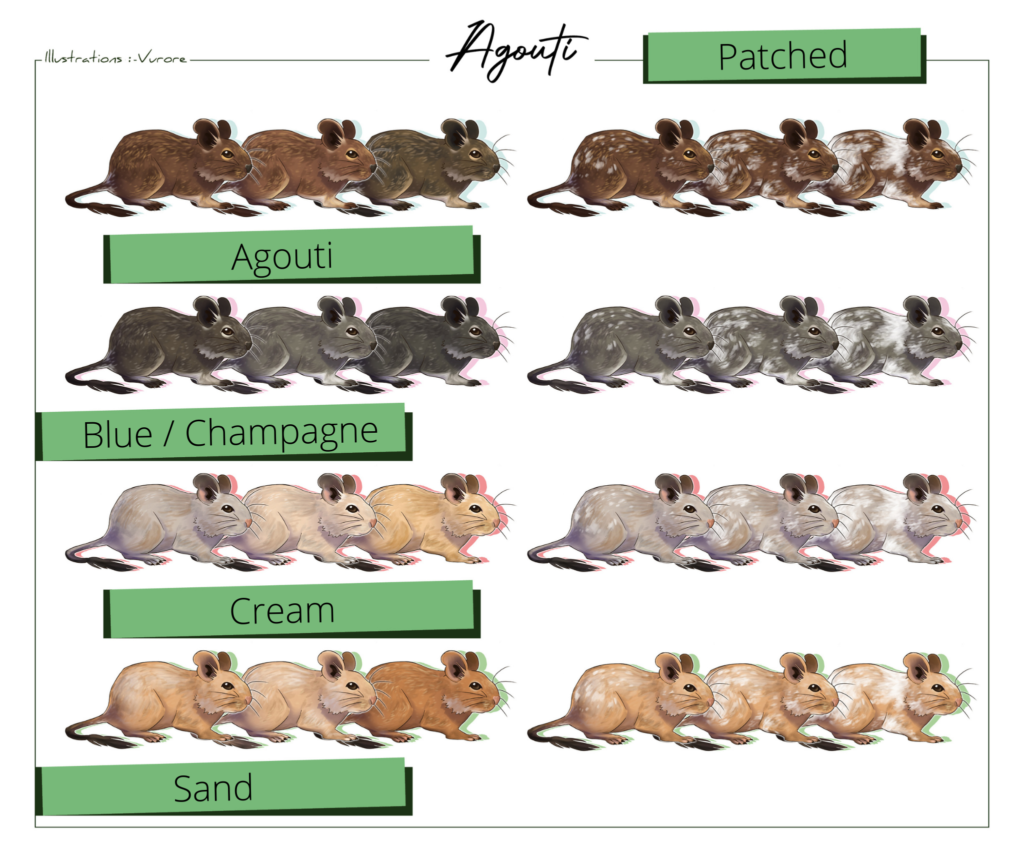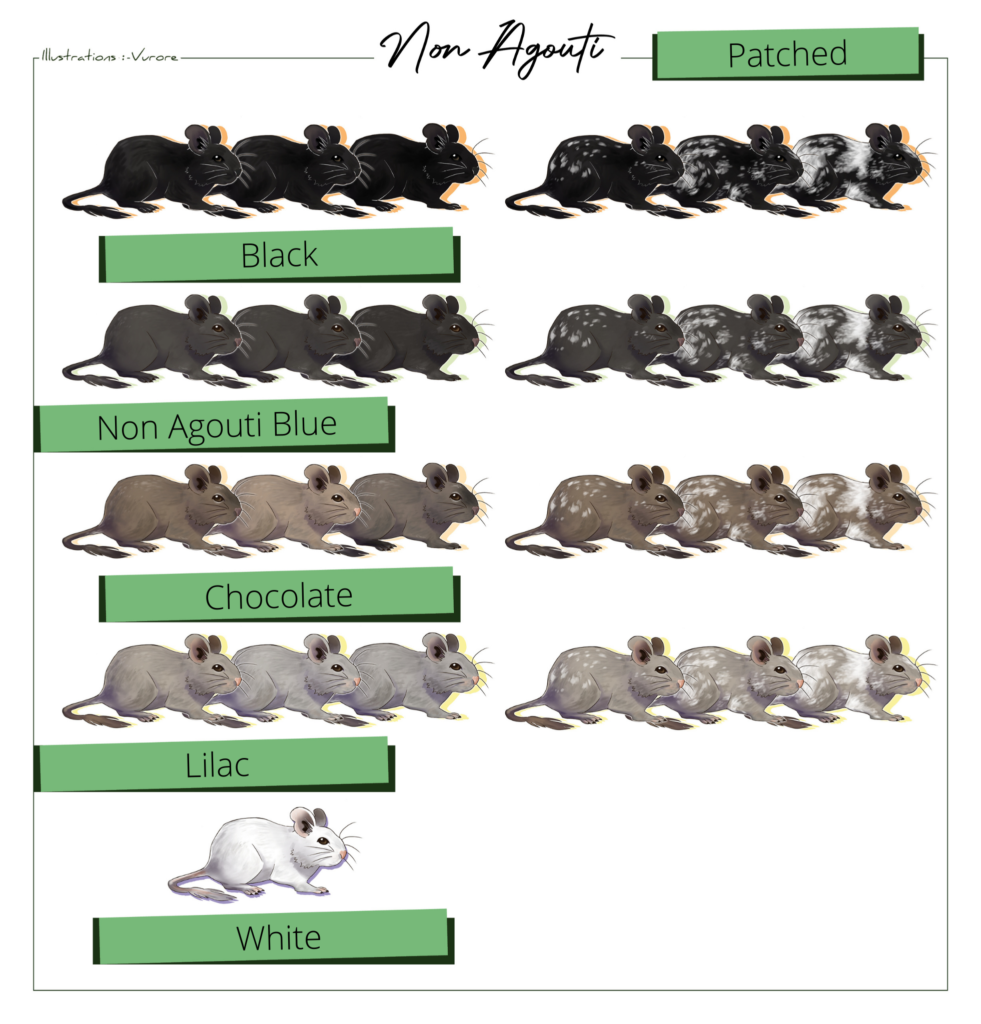For a few years, degu breeders have been developing different colors, more or less distant from the natural color of the degu. This requires a rigorous selection of individuals and a standard of breeding. The work of a breeder goes beyond the only “creation” of a new color but must take into account in particular the health and the behavior of the degus.
The Worldofdegus.com website strongly encourages all its readers to prefer adoption or purchase from serious breeders rather than buying in pet shops. However, setting up breeding standards can help regulate health problems and avoid physical deformities in the degu. This is a tool for breeders.
Introduction
Mammals have two pigments that will determine the color of their coat. This applies of course to the different coats of the Octodon degus. The first pigment is eumelamine, which is brown to black. The second type of pigment is peomelanin, lighter than the first type, approaching beige to red, even light brown. The diversity of coat color is determined by the amount of these pigments and their quality in each fur and is controlled by genes. The color of the pigments can be degraded or even “blocked” by the cells of the epidermis, during the “transport” of the pigment 01.
To constitute the pigmentation gene, there are two types of genes: homozygous or heterozygous genes. When the gene is homozygous is represented by two alleles that are completely identical. In the degu, this means that the gene for color consists of two equivalent alleles. On the contrary, when the gene is heterozygous, it means that the alleles are different. One of the alleles corresponds then to a color while the second corresponds to another.

The dominant allele is the one that determines the visible color of the coat, while the recessive allele is not visible. We make the difference between the phenotype (set of observable traits that characterize a living being) and its genotype (set, or given part, of the genetic composition of an individual). Thus, the genotype contains the recessive and dominant alleles, while the phenotype is the expression of the dominant alleles.
In cases of double dominance of heterozygous alleles, if both colors are expressed, we speak of co-dominance, which then “mixes” the pigmentation.
But to know even more about the genetics of the colors of the degu, it is also necessary to know the different loci. The locus is a fixed point that is found on each chromosome. There are several loci known in the Octodon degus, which play important roles on the coat.
Finally, when an animal or plant population reproduces identically, generally having a shared genotype and being homozygous, we speak of a pure lineage. These lines will give an offspring that will always be similar to the parents. These pure lines are obtained by inbreeding, by reproducing brothers and sisters over many generations. They are used in laboratories so that when experiments are done several times on animals, the individuals are as close as possible to each other. This use of pure lines allows to avoid falsified results02.
Exemple

The color of the iris of human beings is a good example. The gene for brown color is dominant while blue is recessive. In the following case, parent 1 has blue eyes and is homozygous, so his code is bb. Parent 2 has brown eyes, but is heterozygous with a blue allele, so his code is Bb. We notice that the children of these two parents have a 50% chance of having blue eyes and a 50% chance of having brown eyes, while being heterozygous. If parent 2 had been homozygous, 100% of the children would have had brown eyes, because brown is dominant and the blue recessive.
Genetics of colors
Currently, 6 distinct loci are known in the genetics of the Octodon degus, determining its color:
- Locus A – Agouti: it is responsible for the striped fur (dominant A) or the unicolor fur (recessive aa). This locus is linked to the Extension locus.
- Locus B – Brown: this locus is responsible for the expression of eumelanin (dominant B) and pheomelanin (recessive bb).
- Locus C – Color: locus responsible for the presence of pigment (dominant C) or the absence of pigment (recessive cc).
- Locus D – Dilution: it is responsible for the dilution of the pigment (lightening of the color) in the recessive dd form, it is dominant in the D form when the coat is not “diluted”.
- Locus E – Extension: this locus is responsible for the extension of the pigment in the fur shaft in the ee recessive form and dominant in the E form, when there is no pigment extension. This locus is related to the Agouti locus.
- Locus W – White patching: locus responsible for the presence of white patches in the coat (dominant form W).
The use of these loci allows to create color code of each degu. This is very useful in breeding to choose the best lines and individuals to reproduce to obtain a certain coloring.
Agouti colors
The agouti coat colors are made of a coat showing fur with several expressions of colors (bicolor, …).

Agouti – Natural color
Genetic code : A* B* C* D* E* ww
The agouti is the natural color of the Octodon degus, it is a coat adapted to its environment, in order to better camouflage itself. The fur is also bicolored, hence this particular coloration. The body is generally brown with black and lighter fur. Its ears are dark. The circumference of the ears and eyes, as well as the ventral zone, is composed of light beige hair. The fur covering the legs is light, almost gray. The agouti fur is composed of a light stripe (pehomelamine) in the center and two dark stripes at both ends (eumelamine). It is at the base of the mutations giving the other agouti coats.




Agouti blue (or agouti champagne)
Genetic code: A* B* C* dd E* ww
Agouti blue degus are overall a fairly light gray with hints of browns and creams, which are close to agouti. Like the agouti, the eye rims, ear bases, and underbelly are lighter, with gray areas on the legs. This is one of the first mutations of the degu’s coat that appeared in captivity. It results from a “dilution” of the eumelamine into a gray coloration. The fur can be entirely grey (disappearance of the light band of the agouti) or bicolored in light and dark grey. Be careful not to confuse this color with the non-agouti blue color, which contains only entirely gray fur.
The champagne agouti color is not yet recognized by breeders, because it is the same mutation, but expressed differently. Unlike agouti blue, the light brown band of pheomelamine is still present, giving a creamy color to the undercoat, which gives the degu brown highlights.



Sand
Genetic code: A* B* C* D* ee ww
The sand-colored degu appeared a few years ago. We can notice that the agouti coat has lightened a lot, especially around the eyes, ears, and ventral sides. It is a recessive mutation, which requires it to be homozygous. It is due to the red pheomelamine, which has spread.
Sand-colored degus have existed for several years, the color is inherited recessively. The lightening of coat color around the eyes, ears, belly, and neck is only faintly visible here. The extension mutation is recessive and homozygous resulting in the spread of red pheomelanin in the fur.



Cream
Genetic code: A* B* C* dd ee ww
Degus with a coat cream are rather quite recent, the coat having mutated from degus color sands and champagne agouti. The coat is much lighter than the sandy one while having possible reminiscences of the champagne color. The coat tends to darken with age, possibly turning gray on the back. As the mutation needs 3 recessive loci, it appears only from the crossing of degus of second or third generation. This color is therefore complex to breed, because of the risk of associated inbreeding.



Non-agouti colors
Non-agouti colors are made up of a uniform coat, expressing only one color. The difference between the two may be difficult to observe in some mutations.

Black
Genetic code: aa B* C* D* E* ww
Non-agouti black degus have a very dark brown fur, due to the presence of eumelanin in the whole fur. Some mutations cover more or less the body until they are expressed. We can find this characteristic quite impressive in the hens of the breed “Ayam Cemani”. In the case of degu, where not all the loci are homozygous, it is possible to find spots or discolorations of other types of colors.



Blanc
Genetic code: * C* * * W*
White degus are not albino, this is a coat that has been highly diluted in color from the sand and blue color. To date, there are no known albino individuals, and it is possible that the locus of albinism is lethal in the degu, as in other animals03.
Strictly speaking, white is not considered a color. It is a patched degu, whose spot is inherited in a dominant way on the whole body. Homozygous white degus (WW) are very rare. They have no skin pigmentation (even around the eyes, ears, and tail), but have a very short life expectancy.
The white degus can be grouped into 2 categories: the very extensive patched and those whose coat becomes white (linked to genetics). This last category remains however very rare. It happens that the white degu is born with pink skin, which will become grey with age.


Chocolate
Genetic code: aa bb C* D* Ee ww
The chocolate-colored degu is obtained thanks to the recessive expression of the b gene. This one then dilutes the pigment in a slightly lighter color, which can observe several variations of the coat.



Blue
Genetic code: aa B* C* dd C* E* ww
The non-agouti blue mutation is related to the dilution of the blue gene. It is possible to find various shades of coat, which are all part of the same color.


Lilac
Genetic code: aa B* C* dd ee ww
The lilac color is recent and not yet widespread. It has a non-agouti coat, with two chocolate and two blue genes. It has a plain, silver-gray coat with no blue or brown discoloration.



Other characteristics
Patched
Genetic code: * * C* * * W*
Some depigmentation spots appeared during the crossings. These degu’s with white areas are called “patched” degu’s. Most colors have patched individuals because the W locus is dominant. The white areas are areas where the skin is not pigmented and thus cause these white fur, easily visible on the fur. It is also observed heterozygous patched degus (ww) with other colored spots, especially agouti, blue, or sandy spots (on white degus).
According to the proportion of white fur in the coat, we can distinguish several categories04 :
- Patched: as soon as white fur appears, but not covering more than 40% of the body.
- Super-patched : the proportion of white fur is between 40% and 70%.
- Mega-patched : as soon as the fur covers more than 70% of the body.





Tricolor
There are now tricolored degus, but it is not possible at this time to determine the genetics of these individuals05. These individuals are very rare.

